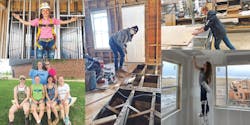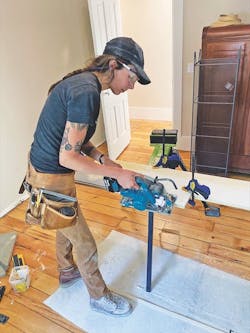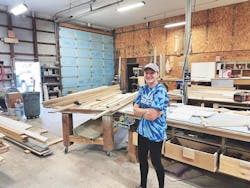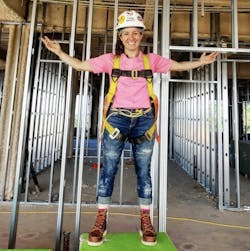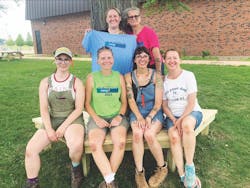Women in Trades: What Their Experiences Tell Us
Deep down, Alaina Dedo always wanted to be a carpenter, but she submitted to the idea that it would never happen. “I didn’t really know where to go or who to talk to,” says Dedo.
During career talks with a school counselor, Emma Wilson was told she’s too smart for construction. “I had been told carpentry wasn’t an option,” says Wilson.
Without a real plan yet a desire for a stable career, Kelly Ireland applied to the plumbing union. “I found out later that twice [the union] tried to send me out to work and the foreman didn’t want a girl,” says Ireland.
Dedo, Wilson, and Ireland’s personal experiences mirror the stories of thousands of women in the trades, which make up just 3.7% of the construction workforce, according to government data.
Construction remains a male-dominated industry with little diversity, but businesses and individuals now see a solution to the labor shortage could rely on the other half of the population: women. That is, if barriers to employment, education, and representation can continue to be eased.
RELATED: A Lesson in Mentorship: Emma Wilson's Carpentry Journey
A Change is Underway
For nearly two decades, the industry has struggled with a severe skilled labor shortage, and the negative effects on businesses and consumers alike only continue to accelerate with an aging workforce and increased need for residential construction.
While the share of women in overall construction hit an all-time high in 2021 at 11%—up from 9.3% in 2002 and 10.9% in 2020—the share of women in the trades trails behind, according to the latest data from the Bureau of Labor Statistics and the US Census Bureau.
But an increasing number of women-focused trade training programs and efforts to inform younger girls and women have popped up around the country: partnerships with the Girl Scouts of America, The House That SHE Built, Hope Renovations in North Carolina, government grants to cities and states, Girls Build in Portland, woman-focused home improvement expertise network Matriarchy Build, and so many more.
Still, the ripples of change from today’s efforts will take time, and once there are more women in the trades, how can the industry both hire and retain them?
It Starts with Representation
Alaina Dedo’s carpenter “pipe dream” as she refers to it, turned into a real possibility the moment she saw a woman in the role.
“I think that was honestly probably the first time that I ever thought to myself, ‘Hey, maybe I could actually do this. She’s doing it,’” recalls Dedo, who now works as lead carpenter at Tony Trapp Remodeling in Madison, Wis. and runs a majority female crew.
Both attracting women to the trades and attracting them to a business begins with visibility and representation. The image of a man in a hard hat working with power tools remains the stereotypical view of a carpenter or someone in the trades, but the effect of viability and representation is tangible.
“While I was in school, I think if I had more options, if I had seen that there is a way for me to be safe in this job, yeah, I would have been less hesitant,” says Emma Wilson, a 19-year-old foreman at Marathon Craftsmen in Valparaiso, Ind.
At Byggmeister Design Build in Boston, a long-time carpenter, Catherine Autio, would be the connection of a newer female carpenter to join the team. Autio’s presence directly impacted Byggmeister’s success with attracting and retaining a female crew of three, says CEO Rachel White.
Social media plays a large role in visibility nowadays, as women in the trades have their own platforms to highlight their work. Lydia Crowder, also known as DrywallShorty on Instagram, has amassed 210,000 followers. Kelly Ireland, owner of TPG Mechanical and Matriarchy Build pro, has 11,200 followers and receives messages often from women both seeking advice and sharing how she’s inspired them to pursue plumbing careers.
Beth Pointer, owner of Done Construction in Baltimore and Matriarchy Build pro, follows many contractors herself, but notes there remain biases, even in online communities.
“I’m on Instagram, I follow a bunch of other contractors, and I think folks have improved, at least in their public-facing selves, but there’s still a lot of that mentality, that it’s a club that they don’t want us in,” she notes.
The Effect of Low Representation
Without representation for so many years, it’s quite often that women will enter the trades as a second or third career move, as when women initially consider careers, construction may not seem viable to them or the information not readily available.
A lack of representation also fuels the opinions of the public, affecting the support from schools and families. As more women do enter and businesses shift to focus on representation, those perceptions have slowly been changing.
I have to break all the stigmas that are built up before I even walk on. They don’t know how I am with a hammer, but they’re going to be worried about how many bathroom breaks I take, or how I wear my hair.
“I remember when I started, and I was talking to a family member, and they said, ‘Well, what are you going to do? You can’t just do drywall,’ and then I’m like, ‘Well, yeah, I can, it’s okay,’” recalls Crowder. “And I think a lot of it has been the acceptance and kind of this rebirth, kind of a renaissance of trades.”
It also fuels perceptions from others in the trades, though it’s changing. Pointer and Ireland both began in commercial construction, and note the unwelcoming environments, hazing, and unfair assumptions on their work abilities.
“I have to break all the stigmas that are built up before I even walk on,” says Ireland. “They don’t even know how I am with a hammer, but they’re going to be worried about how many bathroom breaks I take, or how I wear my hair or are my nails painted.”
Reacting and Retaining
Tony Trapp, owner of Tony Trapp Remodeling, experienced disruptions to his projects and knew he needed a new approach for hiring. It’s what brought him to work directly with Madison Area Technical College to recruit women carpenters from the college’s one year program. All three of his carpenters graduated from the program, one that also features female instructors and hosts projects with Girl Scouts.
Hope Renovations CEO Nora Spencer suggests that if you take the route of job postings, revisit the description. “A lot of time we’ll put in our descriptions that you’ll have to be able to lift 50 pounds. Well, do you have to lift 50 pounds regularly? Ongoing? Or is it occasionally? Because that’s very different,” she says.
Representation on a team shows other people that they can see themselves in a certain career, and White says though it’s a challenge to start building a diverse company from scratch, it all starts with long-term commitment.
“It’s building and continually working on creating an environment that makes people of different backgrounds, people who have been underrepresented in the industry feel like this is a place for them, and creating a culture that is welcoming and open to people who have different family needs, different health needs,” she says.
And for trade partners, it can be as simple as showing appreciation, which goes a long way says Crowder. But going further, the culture shift seeps into traditional work styles in construction, she notes.
“If you have kids, a 12-hour day is really not gonna be realistic for you,” says Crowder. “That could be something that you’re like, ‘Man, I really want to try this, and I really would like to work for this company, but their hours are just not fitting with my schedule.’ A lot of companies need to start thinking in general with retention of employees is having better hours and more flexible hours.”
A large part of creating that environment relies on communication, support, and overall culture. It’s what keeps women, and more people, in a workplace. For Dedo and her carpentry team, Trapp’s monthly check-ins, weekly meetings, and supporting individual goals are what makes the workplace enjoyable—so enjoyable that her testimonials to other female tradespeople resulted in a new employee.
“If we want to get folks in the industry that are historically not in it, we need to think about how we’re going to create an atmosphere so they can succeed,” says Trapp. “So from the basics, we’re providing a company vehicle and all company tools. So you just have to come with a will to learn and some basic experience and the right mindset… And then from presenting a path at the time of interview. With this skill set, here’s where you’re starting, and here’s a path where you can get to a field carpenter or a lead carpenter.”
Most of all, to welcome the industry requires the support of the majority of the industry: men. To move the trades forward into a realm of increased workforce, eased backlogs, and smoother operations, current business environments and hiring focuses may need adjustments. And to women considering the trades, 19-year-old foreman Emma Wilson has one message: “It’s the best decision I’ve made.”
